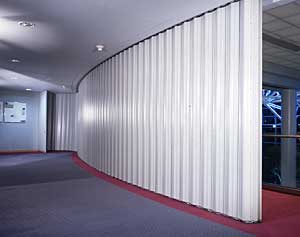Horizontal Sliding-Door Systems: Opening New Opportunities for Design Flexibility
Airports face a similar but slightly more practical design challenge: they must accommodate the rapid movement of thousands of patrons while complying with life safety requirements and building security. Horizontal accordion-style sliding doors can emerge from recessed walls and seal off openings as large as 60 feet, as is the case at Orlando International Airport. The systems are in use at the major airports in New York, Washington, Chicago, Newark, Houston, Miami, and Los Angeles, as well as others.
 |
| Getty Museum, Los Angeles, California. Architect: Richard Meier & Partners, Architects. Photo credit: Sutton Photography In addition to the application at the Getty Museum in Los Angeles, horizontal sliding-door systems are used to separate galleries at the Guggenheim Museum in Bilbao, Spain. |
Government facilities have seen a dramatically increased need for building security in the wake of the September 11, 2001 terrorist attacks on New York and Washington. At the Pentagon, where American Airlines Flight 77 slammed into the side of the building and killed 125 occupants, 38 horizontal accordion-style sliding doors were in place in the building's vast network of corridors.
They were there in part because conventional swinging doors at the end of long corridors were cumbersome for the electric carts that were used to transport paperwork and supplies. Some of these doors in the 26-foot-wide corridors had actually been chained open.
 |
| Getty Museum, Los Angeles, California. Architect: Richard Meier & Partners, Architects. Photo credit: Sutton Photography In addition to the application at the Getty Museum in Los Angeles, horizontal sliding-door systems are used to separate galleries at the Guggenheim Museum in Bilbao, Spain. |
On September 11, the sliding-door systems took on new significance, activating instantly at the signal of alarm. One general recalled that he saw a fireball racing down a corridor and felt certain he would perish, but the horizontal sliding door drew shut, sealing off the inferno and allowing him to escape.
Courthouses that require free-flowing access for judges and attorneys but need to be similarly sealed off in a security emergency have also turned to the systems as a design solution.
Public Venues and Places of Assembly
Sliding-door systems are also in use at hotels including Walt Disney World, the Hyatt, Hilton, Marriott, Fairmont, Ritz-Carlton, and Intercontinental chains, around atriums and as a retractable protective barrier around elevator lobbies, needed to prevent the vertical migration of fire. They are commonly used in sports facilities for football, baseball, basketball and hockey, where large numbers of fans must pass through openings and corridors that must be sealed off in an emergency while still providing emergency egress.
Shopping malls, with their distinctive fire safety and security requirements, use horizontal sliding-door systems as long as 100 feet, which curve and snake along the line of the desired protective barrier. At virtually every gaming facility in Las Vegas, the systems take the place of conventional swinging doors that limit design flexibility and can be cumbersome for large numbers of guests moving between spaces. At Caesar's Palace, the system serves as a fire-assembly separator, between the casino and the shopping center.
|










